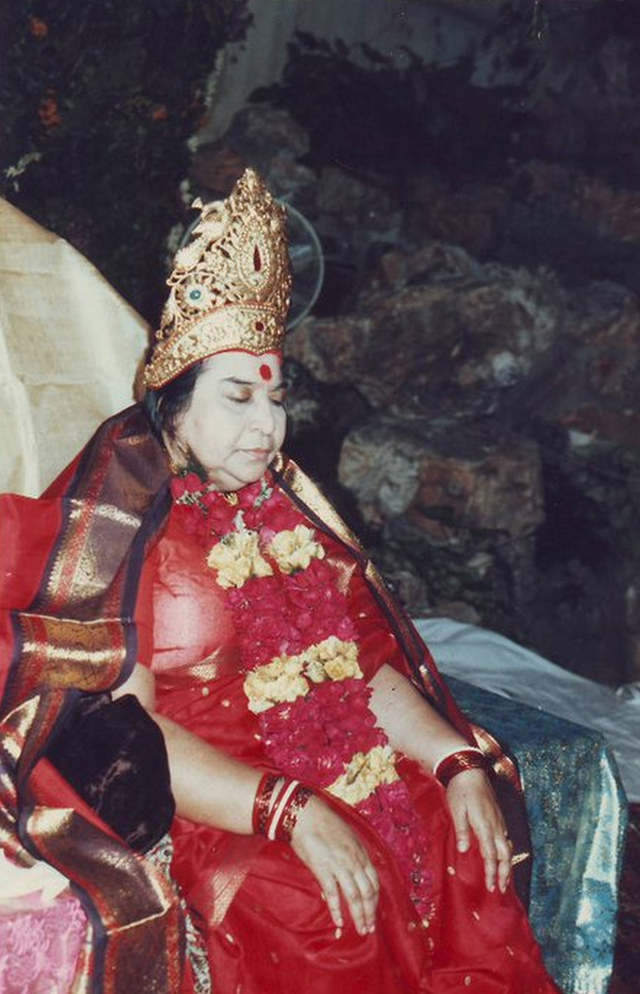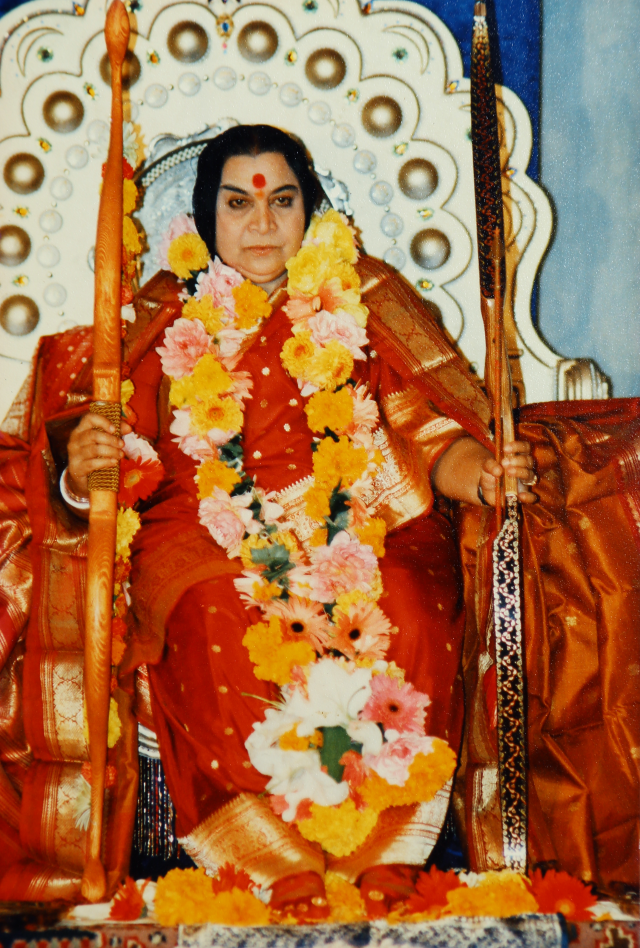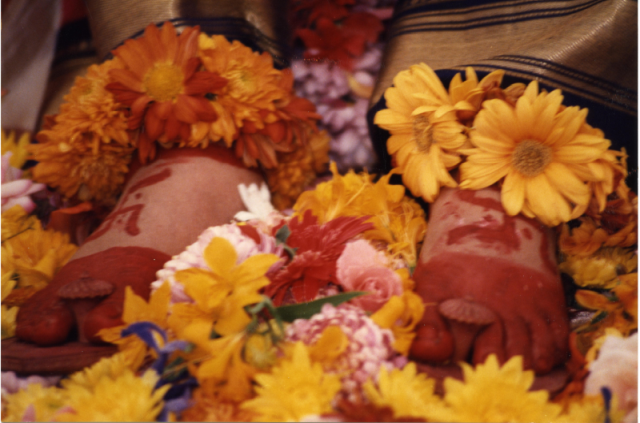2021 Celebrating the Birth of Śhrī Rāma: “He was the Embodiment of Dharma”

"We have gathered here on the occasion of Rām Navamī. Everybody has said, “Mother please tell us about Śhrī Rām.”
You know that Śhrī Rāma has a very important place on our chakra, He is situated on our right Heart. Śhrī Rāma has taken the place of father hence if there is lack in the responsibility or love from father this chakra is caught. In Sahaja Yoga we to understand that Śhrī Rāma and all other Deities have taken the form to fulfill their divine work, in all Śhrī Rāma had a special task. As it was said by Socrates that the Benevolent King has to come the same way Śhrī Rāma had come on this Earth as benevolent king, He came in the form of human being, He even forgot that He was Incarnation of Śhrī Viṣhṇu, forgot about Him but for all world, He was Puruṣhottama Rāma.
In Sahaja Yoga we need to know when we pray any Deity, we have imbibed the specialties and qualities of the particular Deity within us, Śhrī Rāma had many qualities.
You all know his childhood life and you have already heard about his qualities, he was Puruṣhottama he had another quality that in his ruling, he did not care for his wife or children’s in front of his subjects view."
1991-0325 Śhrī Rāma Pūjā (Hindi) (the day after Rām Navamī Day), If You Believe in Śhrī Rāma Follow His Ideal (Our Nature Can Change because He Is Our Ideal and You All Become Ideals for this World), Kolkata, West Bengal, India

"On the night of Full Moon, you should meditate on Śhrī Rāma and surrender yourself to Him for protection.
The meaning of the word rāmachandra is ‘creativity'. You should completely dedicate your creative powers to Him.
Thus you have to take special care of yourself on these two days.
However, on the seventh (Saptamī) and ninth (Navamī) days of Lunar fortnights, you have My special blessings.
Remember that you are specially blessed by Me on these two days.
Make some special arrangements so that you can have proper meditation on these days."
1976-0529 Talk to Sahaja Yogis (Hindi), Dhyān Kaise Karein (How to Meditate), Gita Mandir Hall, Bharatiya Vidyā Bhavan (3rd floor), 29, Kulapati K.M. Munshi Mārg, Chowpatty, Mumbai, Maharashtra, India
"Śhrī Rāma was also a great Devī bhakta, that is, devotee of Śhakti. Before attacking Sri Lanka He performed Devī Pūjā for which He needed a Brahmin for conducting various rites to please the Devī. He then sent for Rāvaṇa the King of Sri Lanka, who was a Brahmin and Devī bhakta. He readily responded and helped Śhrī Rāma in performing the Pūjā of the Devī with all nine types of rites."
1998-0405 Śhrī Rāma Pūjā (Rāma Navamī), House, Noida, Uttar Pradesh, India
"Śhrī Rām was the ideal husband whereas Śhrī Sītājī was an ideal wife and the children born to them, known as Lav and Kuśha, were also the ideal sons. Śhrī Rāma wanted to establish the high ideas to be emulated by humanity. Socrates, as you all know called Him a benevolent king.
Actually, all the events that occurred in the life span of Śhrī Rāma like Ahilyā Uddhār [Deliverance of Ahalyā], Mokṣha to [Ādivāsin woman Śhabarī], killing of Bali, who was the king of monkeys, who was doing adharma, as well as the killing of Rāvaṇa because he kidnapped Śhrī Sītājī, to establish the Rule of Dharma. Actually, Śhrī Rāma was Dharmātīta, i.e., beyond Dharma. But strictly speaking, Dharma was in-born in Him, i.e., He should be called Dharmasthita. He was the Embodiment of Dharma."
1998-0405 Śhrī Rāma Pūjā (Rāma Navamī), House, Noida, Uttar Pradesh, India

"So, one belongs to Paraśhurāma and one belongs to Rāma."
[referring to the bows]
1987-1004 Śhrī Rāma Pūjā (Dussehra Day), Maryādā Puruṣhottama and Message of Sītā's Life (Very Great Achievement Within Ourselves), Centre International, Les Avants, Switzerland
"Shrī Rāma was the Puruṣhottama – means He was the best among all the human beings. That means He incarnated as a human being, total human being, showing all the qualities of human beings. Like He was, He married the Lakṣhmī principle that was Sītā, and then also He lived a normal married life. When He gave Her up He lived like an ascetic to show how a man should lead his life in proper dharma as a married man. And even when the wife has gone away, how He was leading a life of complete chastity."
1989-0814 Śhrī Kṛiṣhṇa Pūjā, Secondary School, Saffron Walden, UK

"A king has to be like Rāma. He has to be like Rāma. Representing your will, your goodwill, your sense of proper judgment, fair play, and righteousness.
If the king is not righteous then your collective goodwill will go against the king."
1982-0402 Śhrī Rāma Pūjā, Rāma Navamī, Āśhram, 44 Chelsham Road, London, Clapham, UK
"Śhrī Rāma came on this Earth to establish the institution of benevolent king. The political development and the political evolution started from this [right] side. He is the one who gave leadership as a benevolent king, the one who represents God and who is a king. The idea of a king related to God came from Śhrī Rāma. But the modern kings are not like that, they have no relation with God.
On the contrary, they are horrid people. Some of them are nothing but satanic people, absolutely Satan is there and you can see from the way they lead their lives, and they have led their life before. So the benevolence of Śhrī Rāma is here [shows the right Heart] to be followed by all the political leaders and all the people who are at the helm of affairs. He is the ideal that was created for human beings, to run their authority as the head, or the loving compassionate benevolent leader of the people, who has to govern them by making them respectful, by respect. And if human beings create such things who are not respectable, those who have no human values, those who have no moral courage, those who are selfish, those who are self-centered, then they have nothing to do to be there.
So this is the position of Rāma who is the Father. So the head of every state has to be the father of his subjects, that’s what He has tried to show by His life. So much so that He had to sacrifice His beloved Wife, whom He loved so much"
1981-0929 Navarātri Pūjā (1st Day), Sahaja Yogi's Home, Staten Island, New York City, NY, U.S.A.

Shrī Rāmachandra charanau manasā smarāmi
I worship the Feet of Śhrī Rāmachandra in my heart.
Shrī Rāmachandra charanau vachasā gṛunāmi
Through my songs and prayers, I praise the Feet of Śhrī Rāmachandra.
Shrī Rāmachandra charanau shirasā namāmi
I bow at the Feet of Śhrī Rāmachandra.
Shrī Rāmachandra charanau sharanam prapadye
I surrender at the Feet of Śhrī Rāmachandra.
Auṃ Twameva sākṣhāt Śhrī Sītā-Rāma sākṣhāt Śhrī Ādi Śhakti Mātājī Śhrī Nirmalā Devī namo namaḥ!
Vaishnav Jan To Tene Kahiye
video
Śhrī Rām Kahe Samjhaye
video
Śhrī Mātājī singing Raghupati Rām
video
Śhrī Rām Kavach Part 1 by Pt. B. Subramanian
video
Śhrī Rām Kavach Part 2 by Pt. B. Subramanian
video
Āratī and the Three Great Mantras
video
Thumak chalat Rāmachandra
Thumak chalat Rāmachandra
Bājat painjaniyan
(Baby) Śhrī Rām walks, swaying unsteadily
(Baby) Śhrī Rām ... His anklets ring in tune with His steps
Kilaki kilaki uthat dhāy girat bhūmi latapatāy
Dhāy māt god let dasharath kī raniyān
Laughing joyously He stumbles around on the ground
He is fondly picked into the laps of King Daśharath’s queens
Thumak Chalat
video
"That is a very beautiful song was written by him. But still, the description of a child, how when he runs when he runs, when he jumps, when he walks it’s a beautiful songs about Śhrī Rāma.
Ṭhumko atta hai who – Ṭhumaka chalat Rām[a]chandra, atta hai kya?
[In Hindi:] Do you know the song ‘Ṭhumaka chalat Rām[a]chandra’ ...?
[In English:] Now these words are such that we cannot explain in English, but when they walk, you know, with – started walking,
so their body, you know, moves in a way that’s called ‘ṭhumakanā’ [toddle, waddle] in Hindi language. So described by Tulasīdāsa, as Śhrī Rāma is walking in that way.
‘Ṭhumaka chalat Rām[a]chandra’. And His anklets are singing and then He’s looking round and every pebble on which He’s walking is reflecting Him, like the souls in which He’s reflected."
1994-0405 Talk to Sahaja Yogis, Picnic, Lane Cove National Park, Lane Cone Valley Walk, West Pymble, Sydney, New South Wales, Australia
Jai Śhrī Mātājī!
On behalf of the festivity team!